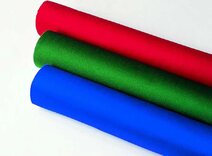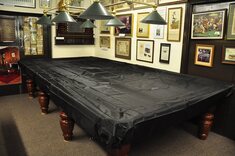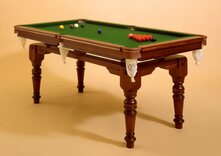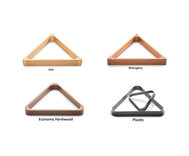The Rules of Snooker
The following is a basic set of instructions for the friendly play of the game of Snooker including additional comments designed to assist with the understanding of the game. Note: 1 foot = 30.48 cm
See also: Buy Snooker Tables, Equipment & Accessories.
Equipment
A full-size Snooker table measures twelve feet by six feet, one and a half inches and has a baize-covered slate bed. The four edges of the table feature rubber edges covered in baize called "cushions". Six "pockets" are situated one at each corner plus one at the centre of each long side of the table into which the balls can drop. The six pockets normally have a net or a small collecting channel to catch the balls. Two feet, five inches from one end, a line is drawn across the table called the "baulk" line. Any ball between the baulk line and the nearest end is generally referred to as being "in baulk". A semi-circle is inscribed within the baulk area with is axis as the middlepoint of the baulk line and with a radius of eleven and a half inches. This semi-circle is termed the "D". At the other end of the table, twelve and three-quarter inches from the end cushion, a spot is centrally inscribed as a starting point for the red ball. The cue ball is struck with tapered sticks featuring a striking tip called "cues". The cue tips are chalked to prevent a slippery contact with the ball. There is almost always an additional accessory available called a "rest" which is like a cue with a cross on the end upon which the cue can be rested to extend its playing length. Quite often, a "full-butt" and a "half-butt" are also available - these are much longer rests with arched fixments on the end that come with their own long cues for playing very long shots. In snooker, one white cue ball is used by both players together with 15 red balls worth 1 point each and 6 coloured balls worth differing points viz:
- Yellow - 2 points - initially placed on the right corner of the D as looked at from baulk.
- Green - 3 points - initially placed on the left corner of the D as looked at from baulk.
- Brown - 4 points - initially placed on the middle of the baulk line directly between the yellow and green balls.
- Blue - 5 points - initially placed slap bang in the middle of the table.
- Pink - 6 points - initially placed on a spot midway between the blue ball and the end cushion.
- Black - 7 points - initially placed on the spot used for the red ball in Billiards - twelve and three-quarter inches from the middle of the end cushion.
The Objective and the Start
The objective is to score more points that the opponent by potting balls and, less commonly, by playing snookers that will force the opponent to make a foul stroke and thus give points away. Players flip a coin to decide who goes first. To prepare for the first shot, the player concerned sets the cue ball anywhere within the D so that it can be aimed at a red ball.
Basic Play
Each turn is called a "break" and consists of a series of strikes of the cue ball that come to an end when a player makes a non-scoring strike or a foul stroke. While there are reds on the table, a break must always start by potting a red. When a red has been potted the player must next pot a nominated coloured ball (if it is not obvious which colour is being aimed at, the player is required to orally make this clear). A coloured ball that has been potted after a red is immediately returned to the table on its home spot. After a coloured ball, another red ball must be potted followed by a colour and so on until there are no red balls left. After the final red ball and its accompanying colour have been potted, the balls must be potted in order starting with yellow and finishing with black. In all cases, the next ball to be potted or colour nominated to be potted must be the first ball struck by the cue-ball or a foul shot is declared. So when a player has next to pot a red ball, if a ball other than a red ball is struck first, it is a foul stroke. As soon as the break comes to an end the other player has a chance to make a break which must always start with a red ball if there are any left, regardless of how the last break ended. The cue ball must be played from where it finished after the previous shot unless it went in-off. Once all the reds have been potted breaks start with the lowest value colour and continue through to the black ball. Points are scored according to the value of each ball potted. Snooker is not all about potting balls - very often it is more advantageous to play safe by putting the cue ball into a position such that the the opponent will find the next shot very difficult to play or to score from. Whenever a player is not able to directly play the ball to be struck with a straight shot, that player is said to be "snookered" on that ball. In this case the opponent is required either to swerve the white ball around another ball or to bounce the cue ball off one or more cushions in order to hit the target ball. With either type of shot, it is difficult to judge the outcome and so the player who engineered the snooker has a good chance either of winning points because the opponent plays a foul shot or at least benefiting from a good position for the next turn.
Common Foul shots
A foul shot is declared in any of the following scenarios.
- The cue-ball strikes first a ball other than the next ball to be potted or the colour nominated to be potted.
- Whenever the cue ball goes in-off (into a pocket) or leaves the table. The ball is placed anywhere in the D by the next player before the next strike.
- Whenever an incorrect ball is potted. For instance, if the red is being played but the blue ball gets knocked into the pocket.
- If the ball being played is the black or the foul occurred because the black ball was struck first incorrectly or potted incorrectly, then seven points are forfeited.
- If the ball being played is the pink or the foul occurred because the pink ball was struck first incorrectly or potted incorrectly, then six points are forfeited.
- If the ball being played is the blue or the foul occurred because the blue ball was struck first incorrectly or potted incorrectly, then five points are forfeited.
- Otherwise four points are forfeited.
- After any foul shot, the player who would normally play next may choose to allow the fouling player to take the next shot, instead.
- If, following a foul shot, the next player is is snookered, that player may take a "free ball". In this case, the player has the option to play any ball on the table as if it was the ball that should properly be played next. Thereafter play continues normally. So if a free ball occurs on a red, the player may play any colour as if it were a red, after which a coloured ball is nominated. The shot after that would be on a red ball if available - the yellow otherwise. If a free ball occurs on a coloured ball after all the reds are potted, the player will attempt to pot any nominated ball and the next shot will revert to the lowest value ball.
Less oft-used rules
If the cue-ball ever comes to rest touching another ball, a "touching ball" is called. If the ball being touched is the ball to be played or is nominated as such by the player, then the player is counted as having played the ball already. Regardless, the player must play away from the ball in order to avoid playing an illegal push shot. Sometimes a coloured ball that has been potted after a red cannot be returned to the table on its home spot due to being covered by another ball. In this case, the spot of the black is used or, if that is not available, the pink spot and so on down to the yellow spot. If ALL Spots are occupied, the ball is placed as close as possible its home spot on an imaginary straight line from its spot directly away from baulk. If, with Black or Pink, there is no room to do this, the ball is placed as close as possible on an imaginary straight line from its spot towards baulk. Less common foul shots are listed below:
- If the player plays a "push shot". This happens if the targeted ball is close to the cue ball and the cue tip is still in contact with the cue-ball when it strikes the target ball.
- In the case of a "touching ball", the player must play away from the ball - if it moves then it is a push shot and a foul.
- If the cue-ball hops over the ball being aimed at, this is deemed a "jump shot" and is a foul stroke.
- If the cue-ball is struck twice.
- If a ball is touched before it has finished rolling.
- If the player strikes the cue ball without at least one foot touching the floor.
The End
Eventually all balls except the black have been potted. At this stage, if the difference in score is more than seven points, the game ends since it is only sporting to assume that a player will not miss a direct shot and so there is no way for the losing player to win. Otherwise, the last ball is potted in the usual way. If the game is drawn, then the black is re-spotted and the cue ball is moved to and played from anywhere within the D. The players flip a coin to decide who plays first and play continues. The player who pots the black wins the game. At any point during the game a player can resign the game. A player would normally resign when the score is such that even with all the balls and two or three snookers he would not overtake the other player.
These rules are provided by Masters Traditional Games, an Internet shop selling quality traditional games, pub games and unusual games. For general information or for copying and copyright, see our Rules Information page.
Our rules are comprehensive instructions for friendly play. If in doubt, always abide by locally-played or house rules.
Copyright James Masters, 2025. All rights reserved.





































